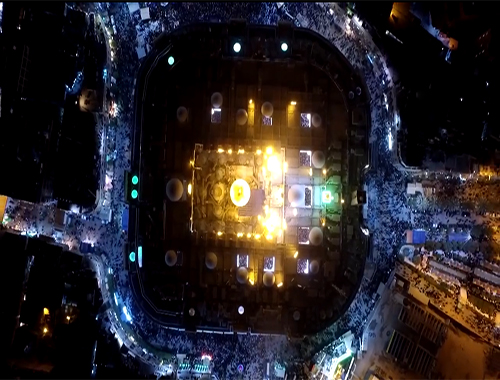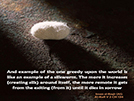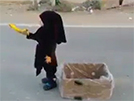Tawaf
- Details
- Hits: 2429
Tawaf
--------------------------------------------------------------------------------
Tawafisan essential part (rukn)of `Umrah, and the tawa f al‑ziyarah (also called `tawaf al‑'ifadah')isa rukn of the Hajj al‑tamattu; Hajj al‑'ifrad and Hajj al‑qiran. As said earlier, the assumption of ihramisthe first act of the pilgrim regardless of whether he comes for `Umrah mufradah or for any of the three types of Hajj.
Now, after the assuming of ihram, what is the next step for the pilgrim? Is it tawaf, or wuquf, or something else? The answer is: it depends on the purpose (niyyah)with which the pilgrim assumes ihram. If it is `Umrah, then the next step is tawaf, regardless of whether it is `Umrah mufradah or `Umrat al‑tamattu`' Thus tawafisthe second step for the mu'tamir (pilgrim intending `Umrah), by agreement of all the legal schools.
However, if the purpose of ihramisHajj only‑‑such as in the case of pilgrim on Hajj al‑'ifrad, or one intending to perform the Hajj al‑tamattu` after getting through the acts of `Umrah‑‑the second step is (as shall be explained later) wuquf in `Arafat. In other words, one who enters Makkah with the sole purpose of `Umrah or Hajj al‑tamattu` performs tawafbefore everything else, then sa’y and then taqsir. After this, if on Hajj al‑tamattu`, he assumes ihramfor a second time; but he is not required to perform another tawafafter this ihram. The tawaf(pertaining to the Hajj acts), as we shall explain, comes after getting through the wuquf at `Arafat and passage through Mina.
Kinds of `Umrah in View of the Ahl al‑Sunnah
The imams of the four Sunni schools distinguish between three kinds of tawaf:
1. Tawaf al‑Qudum: It is the tawafperformed by the `outsiders', (i.e. those coming from outside Makkah and from beyond its outskirts within a radius of 88 kms.) on entry into Makkah. It is similar to the two raka'at of salatperformed as tahiyyat al‑masjid (lit. `greeting of the mosque'), and so is also called `tawaf al‑tahiyyah'' The four Sunni schools agree on its being mustahabb, and no penalty is required for default according to all except the Malikis who require a blood sacrifice.
2. Tawaf al‑Ziyarah: This tawaf(also called `tawaf al‑'ifadah')is performed by Hajj pilgrims after getting through the acts of Mina, the ramy of jamarat al‑`aqabah, the sacrifice (dhibh), and the halq or the taqsir. The pilgrim performs this tawafon returning to Makkah. It is called `tawaf al‑ziyarah' because it is performed on the visit (ziyarah)to the Ka'bah after leaving Mina. It is called `tawaf al‑'ifadah' because the pilgrims pour forth (`ifadah' means `pouring forth') into Makkah from Mina. It is also called `tawaf al‑hajj' because by consensus of all the schools it is rukn of the Hajj.
After performing this tawafall things become permissible for the (Sunni) Hajj pilgrim, even sexual intimacy with women. The Imamiyyah, who disagree, say that sex is not permitted before performing the sa’y between Safa and Marwah followed by a second tawaf, which they call `tawaf al‑nisa'.' This shall be further clarified presently.
3. Tawaf al‑Wada`: It is the last tawafperformed by the Hujjaj before departing from Makkah. The Hanafi and Hanbali schools consider it obligatory, though all that is required of the defaulter is a sacrifice. The Malikis consider it mustahabb and do not require any penalty for the default. Al‑Shafi'i has two opinions on this matter. (al‑Mughni, al‑Fiqh `ala al‑madhahib al‑'arba`ah, Fiqh al‑Sunnah)
Kinds ofTawaf from the Imamiyyah Viewpoint
The Shi`ah agree with the Sunni schools about the legitimacy of the above three kinds of tawaf, and regard the second tawafi.e. tawaf al‑ziyarah as a rukn of the Hajj whose omission makes the Hajj invalid. [1] However, the first kind, i.e. tawaf al‑qudum isconsidered mustahabb, and may be omitted. Regarding the third, i.e. tawaf al‑wada; they agree with the Ma1iki school in its being mustahabb, there being nothing on the defaulter.
However, the Shi`ah add another kind of tawaf to the above three, the tawaf al‑nisa', which they consider obligatory, its omission being impermissible in `Umrah mufradah as well as in all the three
kinds of Hajj (i.e. tamattu; qiran, and ifrad). They do not permit its omission except in case of `Umrat al‑tamattu; considering the tawaf al‑nisa' performed during the course of Hajj al‑tamattu` as sufficient.
The schools of the Ahl al‑Sunnah state that there is no obligatory tawafafter the tawaf al‑ziyarah, after which sexual intimacy is permissible. The Shi'ah say that it is obligatory upon the pilgrim, after performing tawaf al‑ziyarah and the sa’y, to perform another tawaf, the tawaf al‑nisa; which derives its name precisely because of the sanction of permissibility of relations with women (nisa')following it. They say that if the pilgrim defaults in regard to this tawaf, sexual relations are forbidden for man and woman (for men even the conclusion of marriage contract), unless he/she performs it in person or deputes another to perform it on his/her behalf; and if he/she dies without performing it or without deputing someone to do it for him/her, it is incumbent upon the heir (wali)to have it performed on the behalf of the dead person. According to them, even in case of a mumayyiz child who fails to perform the tawaf al‑nisa' while performing the Hajj, even if he omits it by mistake or on account of ignorance, women are forbidden to him after adulthood nor he may conclude a marriage contract (`aqd)unless he performs it himself or deputes another for the job.
To summarize, the Shi`ah consider three tawaf's to be obligatory for the pilgrim on the Hajj al‑tamattu`: (1)the tawafof the conjugate `Umrah, of which it is rukn;(2)the tawaf al‑ziyarah (or tawaf al‑hajj), which is a rukn of the Hajj; and (3) the tawaf al‑nisa', which is also an obligatory part of it, though not a rukn similar to the Surat al‑Fatihah in relation to the salat. The Ahl al‑Sunnah agree with the Shi`ah in all except tawaf al‑nisa; which they do not recognize. However, of a pilgrim on the Hajj al‑'ifrad or Hajj al‑qiran, only two tawaf's are required by the Shi`ah. [2]
Entry into Makkah
All the schools agree that it is mustahabb for one entering Makkah to take a bath, pass through its heights during the approach towards the city, enter through Bab Bani Shaybah, raise his hands on sighting al‑Bayt al‑Haram, pronounce takbir and tahlil, and to recite whatever he can of certain prayers prescribed by tradition. The Malikis, however, disagree about the istihbab of raising the hands for the du’a'.
Thereafter, he approaches the Black Stone; if possible kisses it or caresses it with his hand or else just makes a gesture with his hand, and prays.
According to the Imamiyyah, it is mustahabb while entering the haram of Makkah to be barefooted, to chew the leaves of a plant called `adhkhir' used for refreshing the mouth, or to clean the mouth to purge its odour.











